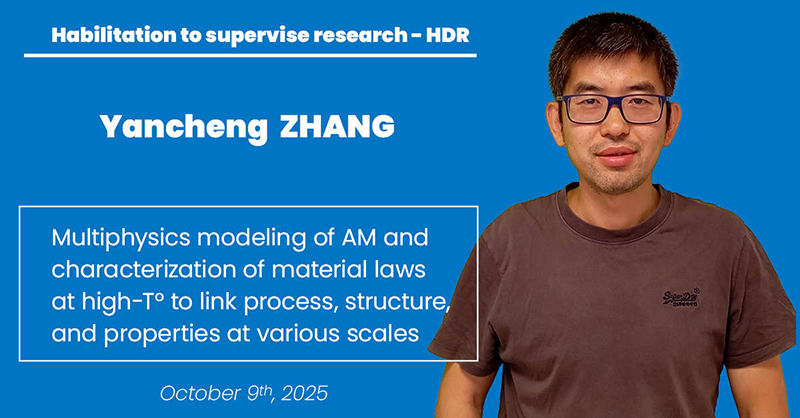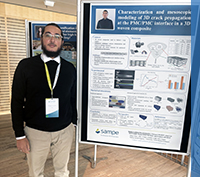HDR Defence of Yancheng Zhang
Multiphysics modeling of AM and characterization of material laws at high-T° to link process, structure, and properties at various scale

Yancheng ZHANG defends his HDR on oct. 9, 2025 at INSA Lyon.
Yancheng will present his research works on Multiphysics modeling of AM and characterization of material laws at high-T° to link process, structure, and properties at various scale in front of the following:
Anthony GRAVOUIL, INSA Lyon, Examinateur
The research ambition is to implement and integrate novel and efficient computational methods (physics-based) at different scales to bridge Process-Structure-Property (PSP) relationship of different material using additive manufacturing (AM), welding and machining processes for both polymer and metal alloys.
Characterization of material constitutive law. From the nanoscale to the part scale, the thermo-mechanical behavior of polymer and metal alloys is characterized from room temperature to solidus temperature. At the nanoscale, the mechanical behaviour of interface debonding is studied for graphene and nanotube reinforced nanocomposites. The interfacial strength between graphenes shows a significant difference compared to those of graphene/polymer and polymer/polymer. The non-isothermal crystallization kinetics, liquid viscosity and densification kinetics of semi-crystallized polyamide 12
(PA12) are characterized. These parameters are used to feed the L-PBF simulation for different scales. The homogenization of the thermal conductivity of the support structure by L-PBF is studied by both analytical and numerical methods. The elastic-visco-plastic mechanical behavior of IN718 is characterized at high temperature. An experimental and numerical platform for the inverse method is established to characterize the mechanical
constitutive laws.
Numerical modeling of additive manufacturing. For both semi-crystalline polymer and metal alloys, different scale models from particle to part are developed to study physical and mechanical behavior during the L-PBF process. For the semi-crystalline polymer, the
relationship between degree of crystallization, temperature, densification evolution and mechanical response is established based on particle, meso and part scale numerical models. To accelerate the computational efficiency of the part scale simulation, the fraction of layer, layer by layer, the multi-shot based superlayers are proposed based on the level-set method, where the non-exposed powder is always considered. For mechanical analysis, the bi-mesh method is proposed to perform mechanical analysis based on a simple mesh. Moreover, anisotropic mechanical behaviour is coupled with grain growth during construction at both the meso and part scales.
Model reduction of part scale simulation. For heavy thermomechanical analysis, several simplified methods are proposed to reduce the computational cost. A modified Inherent Strain method is proposed, which can represent stress and strain, while being limited by the high cost of extracting the Inherent Strain. The Inherent rate method is proposed, which is an on-line prediction method, a computational speedup of about 5 is obtained compared to full simulation. The POD based model reduction is coupled with the Inherent Strain method. A computational speedup of about 100 is obtained. The hyper reduced order model is applied to both fixed and moving frames during the laser welding process, resulting in a significant time gain.
Up to now, a numerical platform of AM modeling at particles, meso and part scales for metal alloys and polymer has been developed
Yancheng Zhang is part of the research team of CEMEF since October 2015, He joined the resaerch team Metallurgy, Mechanic, Structures and Solidification – 2MS lead by Charles-ANdré Gandin.
He is currently co-supervising four doctoral students:
- Eroshan GAMAGE : Development of numerical methods for the simulation the machining process of a part produced by additive manufacturing. Class 2024
- Sylvain DUCOTTET : Numerical modeling of precipitation and optimization of “in situ” thermal treatments on laser powder bed fusion process for aeronautic application. Class 2023
- Zixuan LI : Thermo-fluid-metallurgical and mechanical simulation of the coupling between grain growth, fluid flow and anisotropic mechanical behavior at the track scale. Class 2022
- Trung-Chien VO : Grain Structure based Anisotropic Mechanical Behaviour for Laser Beam Melting Simulation at Part Scale by Reduced-Order Model. Class 2022







